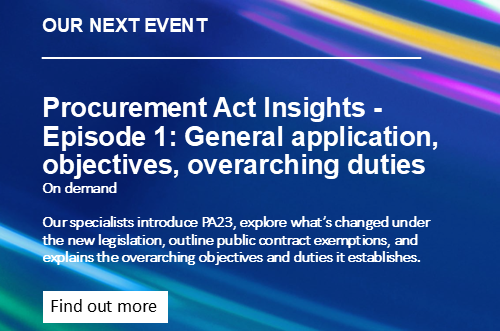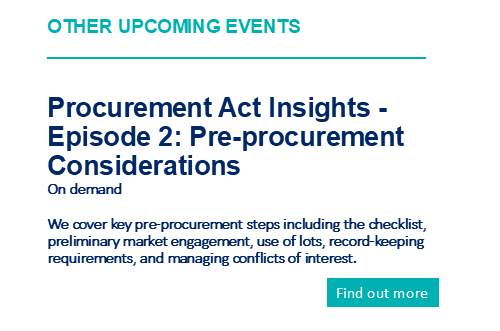- Details
A new investment programme for Local Government – Building on from PFI?
Rob Hann looks back at the local government PFI investment programme rolled out between 1997 and 2010 under the successive Blair/Brown led Labour administrations and explores whether there are lessons to be learned for any new local government investment programme as Sir Keir Starmer’s led Labour Government takes power following the 2024 General Election.
The new Keir Starmer Led Labour Government was elected upon a manifesto which put growth at the heart of its policy making. There are already signs that public/private partnerships and the raising of private finance to fund energy saving and eco-infrastructure projects is at the forefront of the new Government’s thinking. How can the lessons from PFI investment programme help the new government to hit the ground running and build on the foundations of what happened back in 1997-2010?
The Labour landslide following the 2024 General Election has, for me, prompted memories of the last time a Labour landslide happened – back in 1997 when Tony Blair, Gordon Brown and New Labour were swept to power promising major investment in public services, particularly ‘Education, Education, Education’. Back then I was just 9 months into a secondment to a specialist company known as 4ps (‘the public private partnerships programme’ to give it its full title) which was set up by the Local Government Association to help develop the Private Finance Initiative (‘the PFI’) across all of the diverse functions of local government in England and Wales.
When I joined 4ps in 1996, PFI was all the rage elsewhere in the public sector, but by 1997 it had barely registered as an investment option for local government. The omens for 4ps, the PFI (and my career) did not look favourable, given the PFI was a Conservative Government initiative and it had been attacked by the then Labour opposition as a ‘mere accounting trick’. More importantly, banks and other financial institutions were, back then, very reluctant to lend any money to anyone dealing with local government because of the impact and effect of the ultra vires doctrine and case law which had led to some banks not being able to recover monies lent in good faith (e.g. see Allerdale v Credit Suisse and the Hammersmith and Fulham swaps case).
4ps had been lobbying the previous Conservative Government to enact primary legislation to address the bank’s vires concerns and provide a so-called ‘safe harbour’ for lenders but these appeals fell on deaf ears. As the dust settled on day 2 of the New Labour administration it soon became clear that far from my tenure at 4ps ending, my role there was really only just beginning (I became an employee and ended up staying at 4ps – later Local Partnerships – for 20 years).
Virtually the first thing on the new Labour Government’s legislative agenda was the Local Government (Contracts) Bill which became an Act of Parliament just a few months later. This simple piece of primary legislation gave the financial sector the protection it needed to at least consider lending to businesses interested in entering into long-term contracts with local government under the PFI. The Act proved to be the catalyst for prompting what would become a trickle, leading to a flow and then a flood of new PFI projects across all local government sectors.
There were, of course many obstacles and difficulties to be addressed before the trickle became a flood. A huge effort was needed to galvanise sceptical local authorities to embrace the idea of long term contracts and (on the other hand) to build and develop a market of bidders and funders to compete for the right to deliver these projects across such a long time frame, with the associated risks involved.
One problem was – how could relatively small local authorities with limited funds ever afford to pay for significant investment involved in a 20-25 year PFI contract for the whole life cycle and contract term? For local government the New Labour Government made PFI attractive financially by pledging 80% of the whole life costs (capex and opex) and ‘ring-fenced’ that funding to individual local authorities via the revenue support grant in the form of PFI credits (later PFI grant). This simple but highly original incentive to local government made PFI a viable and affordable option for local authorities. Soon, local authorities were queuing up to bid for funding from the relevant central government departments to secure much needed investment for 25 years for say schools, housing, waste management, street lighting and a myriad of other functions.
In order to attract the market to PFI, another innovative step was for the central bodies (and HM Treasury) to make it a condition that before any local authority went to the market to find a service provider, it had to have been given a ‘tick-in-the- box’ by HM Treasury for an allocation of PFI credits. This meant the market would have a high degree of confidence that the LA concerned would be able to afford the contract payments if and when it navigated the procurement cycle to appoint a service provider. The announcement of a major boost in PFI funding to local government coupled with a way of allocating that funding (notionally in the first instance) to individual authorities before those schemes went anywhere near a competitive process to choose a PFI provider, meant that contractors had confidence to bid for such contracts – and the banks had the confidence to lend to contractors – in the (relative) certainty that the authority concerned would have the ability (or ‘covenant’) to meet those payments not just at the start of the contract but for the whole contract term, thanks to funding being guaranteed (effectively) by HM Treasury.
By the end of New Labour’s tenure in 2010 there were over 300 local government PFI schemes in operation across all LA sectors. These projects are governed by contracts, many of which are still in operation in 2024 and beyond. The PFI programme led to an unprecedented turbo-boost of investment in the local government sector which still has impact to this day.
But is anyone exploring what worked well and/or what could and should have worked better with PFI?
For starters, any new investment programme for local government will not have to start from scratch (as the PFI programme did) but instead it can build upon the foundations of PFI programme, taking on board what worked well and discarding what did not. A recent article in the Times (‘Reeve’s plan for growth is build on private cash’ Friday June 21st 2024) perhaps gives some clue as to what form a new investment programme might look like? The article reported that The Future Governance Forum (an influential think tank with close links to the Labour leadership) is looking at models similar to those used by the labour Government’s in Wales and Australia. Like PFI, private companies would be invited following a competitive process, to build, finance and maintain public projects. Unlike PFI, in these new models, the public sector body (or LA) would take an equity stake in a joint venture investment vehicle; soft services (such as cleaning, maintenance and repair) might not be outsourced (or perhaps there is a choice as to whether to engage the market for those services or not) and investors would be required to hire and train staff engaged from the local region to boost employment opportunities.
Public sector stakes in JV companies are not, of course, a new idea. Indeed, both the building schools for the future initiative (a hybrid of PFI model) and the short-lived successor to PFI – PF2 were both based on shared equity models (underpinned by a contract) albeit with the public sector partner taking a minority stake holding. It remains to be seen what type of equity stake and what protections and safeguards might be built into any new joint investment vehicle as standard, if this approach were to be recommended and adopted on a pan-LA basis. This would be a risk sharing model rather than a risk transfer model which was often the mantra heard when PFI’s were procured.
The local government landscape has also radically changed since 1997- 2010 with the relatively recent introduction of Combined Authorities across many regions. Back in the day, there was no sensible way of devolving funding and/or responsibility for either economic development or service provision across a region. Now there are custom build mega Combined Authorities (‘CA’s’) who have that panoramic vision and reach across a region. So, for example, a CA might look across its whole area to explore whether (say) waste collection services could be provided more efficiently by a single collection service across the whole region, offering economies of scale and more stream-lined recycling facilities. Street lighting or highways maintenance contracts do not now need to stop at individual district, unitary or county boundaries. Retrofitting public buildings with energy efficient heating systems or solar energy may be another way CA’s can step up to help regionalise major investment programmes rather than this be fully controlled from the centre (as happened under the PFI programme).
One of the difficulties of the whole PFI programme pan-public sector is that, until comparatively recently, no significant support was provided from individual central government funding departments to support public bodies with the contract management function once these projects had navigated the procurement phase and had entered into operations. Only DEFRA, for the funding of its PFI waste programme, provided some level of financial resource to the local government sector to assist with the operational roll-out of the English waste PFI programme. The DEFRA approach was really helpful in that it retained and facilitated a network for local authorities with waste PFI contracts to regularly meet and swap information and to seek help from each other and from centrally based experts on hand to assist them with their difficult (and often common) contractual issues as they arose throughout the operational period. Sadly, this type of help was not replicated across all local government or indeed other publicly funded PFI projects or sectors. Most councils, once a PFI contract was signed, were left to their own devices to cope with the difficulties and complexities arising the best way they could. The consequence of this lack of central support to public bodies throughout the long and protracted PFI operational period of the hundreds of contracts now heading for contract close over the next decade or so, have only comparatively recently been recognised and steps are now (belatedly) being taken to try to remedy the situation.
What about the conduct and capability of the existing market of PFI service providers?
Who, if anyone centrally, has a handle on how PFI service providers have performed over the life of their respective PFI contracts? How will any feedback and knowledge of contract performance gathered by public bodies/local authorities about individual PFI providers be used, or how could this information potentially be put to good use, going forward? For example, could such information and knowledge be used for the provision of references and/or for future procurement evaluation purposes for both the public body itself and perhaps for other public bodies who wish to know how a contractor performed under the PFI? Some PFI service providers will have outperformed. Some will have done what is necessary to deliver the service and no more and others (let’s say) may have not delivered the service to the required standard.
Facilitation of knowledge sharing by and between public bodies about the performance of PFI contractors on individual PFI projects is an essential step for many reasons. It should, for example, help maintain incentives to provide a good service up to expiry and to help public bodies with the transition to new arrangements and with the consideration of who can and cannot be entrusted with the delivery of public contracts in the brave new post PFI world. Disputes and how they arise and are resolved (if indeed they are resolved) might be a feature of such feedback.
Rob Hann is Head of Local Government at Sharpe Pritchard and can be
Rob has unique insight as to how the PFI investment programme for local government was successfully delivered from zero projects in 1997 to over 300 across all local government sectors by 2015. Rob was one of the original team of advisers from across the professional and sector divide at 4ps (‘the Public Private Partnerships Programme’) which was set up in 1996 by the LGA to help local authorities across England and Wales to deliver PFI projects. For 20 years (between 1996-2016) Rob worked at the forefront of the PFI roll out programme across local government as Head of Legal at 4ps and (later) its successor body, Local Partnerships (‘LP’).
For further insight and resources on local government legal issues from Sharpe Pritchard, please visit the SharpeEdge page by clicking on the banner below.
This video is for general awareness only and does not constitute legal or professional advice. The law may have changed since this page was first published. If you would like further advice and assistance in relation to any issue raised in this article, please contact us by telephone or email
|
Click here to view our archived articles or search below.
|
|
ABOUT SHARPE PRITCHARD
We are a national firm of public law specialists, serving local authorities, other public sector organisations and registered social landlords, as well as commercial clients and the third sector. Our team advises on a wide range of public law matters, spanning electoral law, procurement, construction, infrastructure, data protection and information law, planning and dispute resolution, to name a few key specialisms. All public sector organisations have a route to instruct us through the various frameworks we are appointed to. To find out more about our services, please click here.
|
|
OUR RECENT ARTICLES
December 10, 2025
Sharpe Pritchard appointed to £60m London Boroughs’ Legal Alliance frameworkSharpe Pritchard, one of the UK’s leading public law firms, has been re-appointed to the London Boroughs’ Legal Alliance (LBLA) Solicitors Panel.
November 20, 2025
Strengthening the standards and conduct framework for local authorities in EnglandJames Berry offers his insight into how the proposed changes to standards and conduct rules will affect local authorities.
November 04, 2025
Procuring and operating open frameworks under the Procurement Act 2023Chantelle Pink offers advice to authorities on open frameworks and how to procure them.
October 31, 2025
Building Solar – 5 Top Tips for Solar Farm Construction ContractsSolar farm construction contracts are in focus following fascinating insights into the continuing global uptake and expansion of renewables, and particularly solar, within the 2025 mid-year report of Ember, a global energy think tank.
|
|
OUR KEY LOCAL GOVERNMENT CONTACTS
|
||
|
Partner 020 7406 4600 Find out more |
||
|
Partner 020 7406 4600 Find out more |
||
|
Rachel Murray-Smith Partner 020 7406 4600 Find out more |







 Catherine Newman
Catherine Newman
